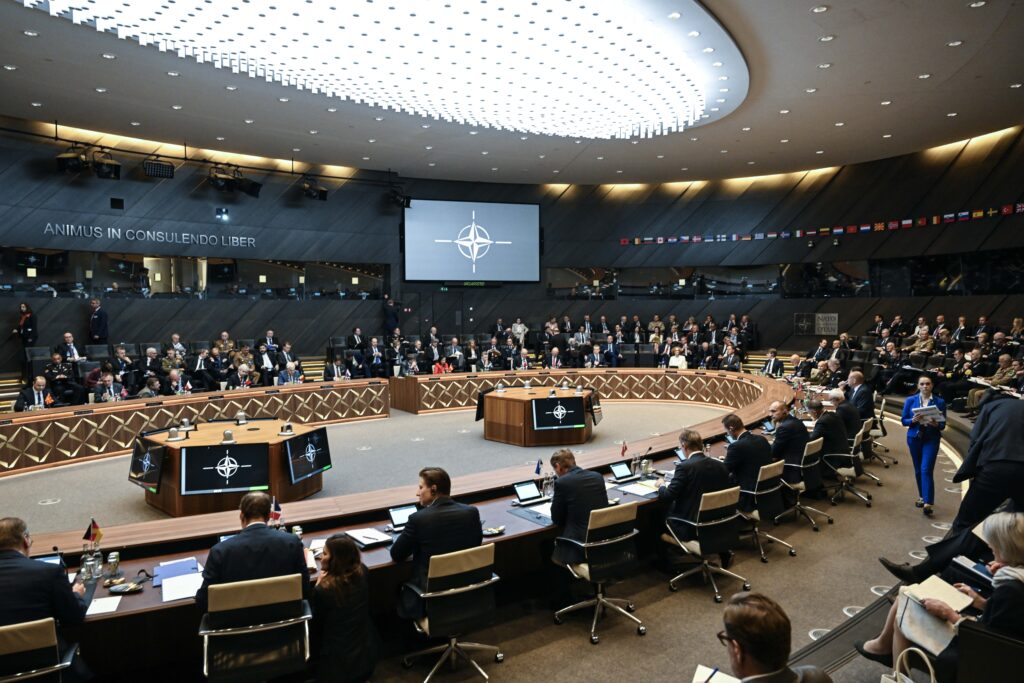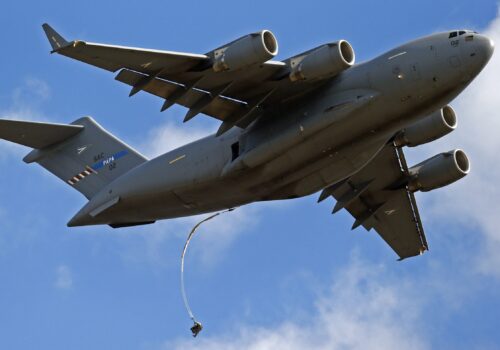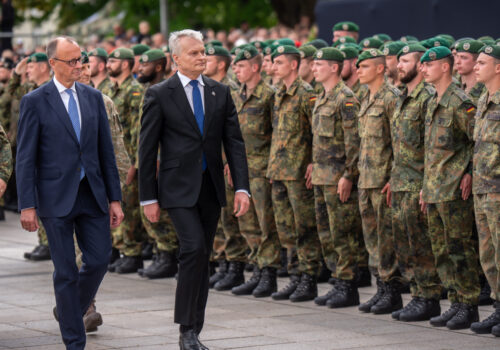When the leaders of NATO’s thirty-two allies meet at The Hague on June 24-25, they are likely to agree on a landmark new burden-sharing goal. What was once thought of as improbable, even preposterous—that allies might agree to spend the equivalent of 5 percent of their gross domestic product (GDP) on defense—now seems imminent.
However, the only way this goal can be fulfilled is by changing the way the Alliance defines “defense.” There is some justification for broadening the definition to include spending on cybersecurity, resilience measures, and critical infrastructure, especially given Russia’s increasing use of hybrid warfare across the Euro-Atlantic. However, the Alliance risks a slippery slope in broadening the definition too much. To guard against this risk, NATO should take steps to identify and define what might be considered truly defense-related and what might be considered mostly civilian-related. Otherwise, the new defense spending goal will not assuage US concerns, reassure allied citizens, or strengthen deterrence against Russian aggression.
Consensus emerging on 5 percent
At the Wales summit in 2014, NATO allies agreed to reach 2 percent of GDP on defense spending by 2024, making that figure a benchmark, among other measures, to guide burden sharing. Although nearly all NATO allies have reached 2 percent or announced plans to do so, the geopolitical environment has shifted. There is now broad consensus within the Alliance that 2 percent is no longer sufficient to meet today’s security challenges. Four separate yet mutually reinforcing demands are driving that assessment.
First, since February 2022, NATO allies have been pouring military assistance into Ukraine to fortify Kyiv’s war effort, and the conflict shows no signs of ending.
Second, allies need to replenish their own stocks and warehouses that have been emptied in support of Ukraine.
Third, allies must fulfill the capability and capacity requirements for the NATO operations plans that were adopted at the Vilnius summit in 2023. These plans outline the specific forces necessary to defend allied territory.
And finally, although plans are not yet finalized, many allies expect the United States to reduce its role in the conventional defense of Europe, given comments made by US Secretary of Defense Pete Hegseth in Brussels earlier this year. A reduced US commitment to conventional defense in Europe would require European allies to contribute even more capabilities to ensure that US decisions do not result in gaps in NATO’s ability to deter and defend.
As a result of these demands, allies are expected to agree to a higher threshold of 5 percent defense spending this month. But why 5 percent?
It’s possible that this figure is driven by the relative spending levels of Russia or, to a lesser degree, China. Experts estimate that Russia directed the equivalent of 6.7 percent of its GDP toward defense and related expenditures in 2024, representing a nearly 40 percent increase from the previous year. Meanwhile, China reportedly increased its defense budget to the equivalent of 7.2 percent of GDP this year as it continues to modernize its armed forces and invest in new capabilities.
However, the most logical reason why the allies are likely to settle on 5 percent is because US President Donald Trump demanded it. Allied fears of US abandonment run deep, and many recall the moment at the 2018 Brussels summit when Trump nearly threatened to pull the United States out of the Alliance.
Challenges on the horizon
Are allies really prepared to spend the equivalent of 5 percent of their GDP on defense? Of course not. Most lack the economic wherewithal to achieve this spending. Many have relatively low or anemic economic growth rates that make it difficult to increase defense spending without painful offsets in other budgetary categories, such as social welfare spending. Moreover, few of the larger allies have the debt “headroom” to engage in deeper borrowing to finance higher defense budgets.
The only viable way to reach 5 percent defense spending is to redefine “defense spending.” Luckily for most European allies and Canada, the United States has signaled its willingness to entertain this lexical exercise. Allies are therefore likely to agree on a target of 3.5 percent for so-called “hard defense” spending and another 1.5 percent for “defense-related” spending, such as infrastructure, technology, and resilience.
Although this rhetorical sleight of hand may enable allies to reach the magic number, it also carries significant risk insofar as allies may seek to count any number of questionable budgetary expenditures as “defense-related.” For instance, to enable the mobility and movement of troops and their equipment, allies must have the requisite road, rail, and port infrastructure—infrastructure that is clearly civilian in nature but may be used by the military. Such items might be considered “defense-related” and therefore count toward the 5 percent goal. But where is the line drawn on such projects? Should all upgrades to ports, highways, railways, and airfields be included as defense measures, under the logic that any European road could be utilized for defense purposes?
Identifying standards and priorities
Russian tanks can’t be defeated by allied rail cars. At the same time, NATO tanks are only as useful as their ability to get to a potential front. Therefore, it’s clear that the Alliance requires both defense-specific capabilities and what might be considered dual-use capabilities to facilitate military mobility, strengthen resilience, and permit NATO to engage and sustain multi-domain operations.
However, the Alliance should establish a process or mechanism to clearly identify standards and priorities for “defense-related” expenditures that strengthen collective defense and societal resilience. The most obvious entity capable of identifying the infrastructure elements necessary to fulfill Alliance operations plans is the relatively new Joint Support and Enabling Command (JSEC). The JSEC, based in Ulm, Germany, is focused on the reinforcement, enablement, and sustainment of NATO forces. It’s building a continent-wide logistical operational picture with a 360-degree approach—for this reason, JSEC is best positioned to identify the infrastructure elements necessary for Alliance operations, plans, and exercises.
At the same time, NATO could turn the European Centre of Excellence for Countering Hybrid Threats (Hybrid COE) into a formal, subordinate Alliance organization. At present, the Helsinki-based Hybrid COE is merely affiliated with NATO (and the European Union) and is not formally part of the Alliance’s civilian or military structure. Pulling the Hybrid COE into NATO’s organizational structure and its chain of command could better enable the Alliance to leverage the Hybrid COE’s expertise for the purposes of identifying approved resilience-related defense spending. As with the JSEC, the Hybrid COE has the expertise necessary to help the Alliance determine which resilience efforts might be appropriately labeled “defense-related.”
Finally, the Alliance should consider augmenting the mission and capabilities of the NATO Science & Technology Organization (STO) so that it can play a role in identifying the technologies that will be necessary for tomorrow’s battlefields. Today, the NATO STO generates, shares, and disseminates advanced scientific knowledge, technological developments, and innovation. In effect, it acts as a research-enabler and a clearinghouse for information. By further empowering it and expanding its mission, the Alliance can better leverage it for the purposes of identifying defense technology investment priorities.
If NATO empowers these organizations to set clear standards on what contributes to the 5 percent goal, the Alliance can ensure that the commitment at The Hague is more than just a headline. NATO must ensure that “defense-related” items truly contribute to collective defense—strengthening deterrence and reassurance.
John R. Deni, PhD, is a nonresident senior fellow with the Transatlantic Security Initiative at the Atlantic Council’s Scowcroft Center for Strategy and Security, and a research professor at the US Army War College.
Ryan Arick is an associate director with the Transatlantic Security Initiative.
Further reading
Thu, Jun 5, 2025
Immediate steps that Europe can take to enhance its role in NATO defense
Issue Brief By Franklin D. Kramer, Kristen Taylor
As NATO members gather in the Hague amid uncertainty about US commitment to the continent and concerns about Russia’s military rebuilding, what can European nations do to deter and, if necessary, defeat threats from Moscow?
Mon, Jun 2, 2025
For NATO in 2027, European leadership will be key to deterrence against Russia
Issue Brief By
NATO lacks the operational integration, logistics, and joint force capabilities needed to quickly counter Russian mass and tempo near its borders. With the United States increasingly focused elsewhere, how can the Alliance retain military superiority in 2027 without overreliance on US military might?
Fri, May 30, 2025
How NATO’s eastern flank is setting the standard for collective defense
New Atlanticist By Justina Budginaite-Froehly
NATO's eastern flank countries have shown that regional coordination can transform vulnerabilities into strategic assets that enhance deterrence and operational readiness.
Image: June 5, 2025: NATO countries ministers attend the meeting of the North Atlantic Council in Defence Ministers' Session at NATO headquarters in Brussels, Belgium, Wednesday, 05.06.2025. Ministers debate a proposal to increase the alliance's defense spending goal to 5 percent of GDP, a move expected to be approved at a high-stakes summit in The Hague later this month. Photo by Wiktor Dabkowski (Credit Image: © Wiktor Dabkowski/ZUMA Press Wire) REUTERS




